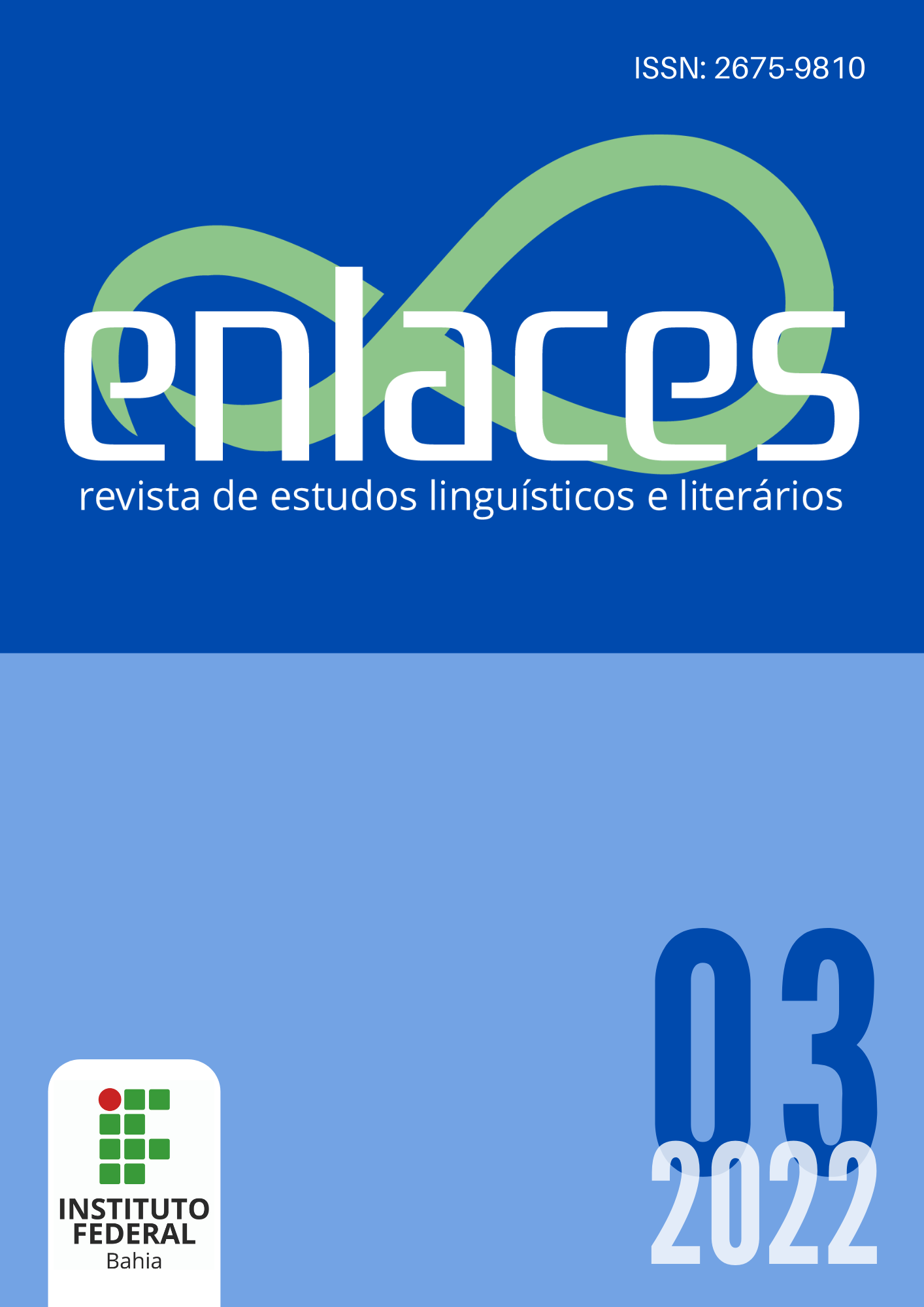The concrete utterance in literary enunciative-discursive tessituras about the Sertão / Northeast / Semiarid
DOI:
https://doi.org/10.55847/enlaces.v3i.975Keywords:
Dialogism, Concrete Utterance, Enunciative processes, Sertão/NortheastAbstract
The term concrete utterance establishes both a rupture and an epistemological position of Bakhtin's Circle about the production of knowledge in Linguistics and Literature. Thus, the study carried out here aims at dealing reflexively and theoretically with the concept of concrete utterance, thinking it through the mobilization of excerpts from works of the so-called literature of the drylands, such as Rachel de Queiroz's O Quinze (2012 [1930]) and Domingos Olympio Braga Cavalcanti's Luzia-Homem (1977 [1903]). Thus, in methodological terms, we proceed with the outline of an enunciative-discursive reading based on Bakhtinian theoretical assumptions. This research is of bibliographical nature, carried out through the survey of references already published about the theme, so the studies were based on some authors such as Volóchinov (2018 [1929]; 2019); Bakhtin (2011 [1979]; 2015 [1975]); Medviédev (2012 [1928]); Santos Filho and Santos (2021); Albuquerque Jr. (2011; 2017; 2019), among others. The results point to the understanding that concrete utterances participate in the life of meanings affiliating themselves to previous and subsequent discursive links, which corroborate or refract certain thematic content forged in the enunciative process, as exemplified by the excerpts of the mobilized literary works, which participate in the construction of the hegemonic notion of Sertão/Northeast/Semiarid. Furthermore, Bakhtinian studies understood that the concrete utterance has specificities and participates in the chain of the life of meanings, building an intelligible reality in the different spheres of human activity and different discursive genres.
References
ALBUQUERQUE JR., D. M. A invenção do Nordeste e outras artes. São Paulo: Cortez, 2011.
ALBUQUERQUE JR., D. M. As imagens retirantes: a constituição da figurabilidade da seca pela literatura do final do século XIX e do início do século XX. Varia História, Belo Horizonte, vol. 33, n.61, p. 225-251, jan/abr 2017. Disponível em: https://www.scielo.br/j/vh/a/JVJF8gfD7f8SHFHBvX9twjm/abstract/?lang=pt. Acesso em: 10 out. 2021.
ALBUQUERQUE JR., D. M. O Rapto do Sertão: a captura do conceito de sertão pelo discurso regionalista nordestino. Revista Observatório Itaú Cultural, São Paulo, n. 25, p. 21-35, maio/nov 2019. Disponível em: https://www.itaucultural.org.br/revista-observatorio-25-sertoes-imaginarios-memorias-e-politicas. Acesso em: 10 out. 2021.
BAKHTIN, M. Os gêneros do discurso. In: BAKHTIN, Mikhail. Estética da criação verbal. Tradução de Paulo Bezerra. São Paulo: Editora WMF Martins Fontes, 2011 [1979], p. 261-270.
BAKHTIN, M. Teoria do romance I A estilística. Tradução de Paulo Bezerra. São Paulo: Editora 34, 2015 [1975].
BIDERMAN, M. T. C. A estruturação do léxico e a organização do conhecimento. Letras de Hoje, v. 22, n. 4, 15 abr. 2014. Disponível em: https://revistaseletronicas.pucrs.br/ojs/index.php/fale/article/view/17049. Acesso em: 10 jul. 2021.
CAVALCANTI, D. O. B. Luiza-Homem. São Paulo: McGraw-Hill do Brasil, 1977 [1903].
KOCH, I. G. V. Linguagem e cognição: a construção e reconstrução de objetos-de-discurso. Veredas, revista de estudos linguísticos. Juiz de Fora, v. 6, n. 1, p. 29-42, 2009. Disponível em: https://periodicos.ufjf.br/index.php/veredas/article/view/25294. Acesso em: 10 jan. 2022.
MEDVIÉDEV, P. N. O método formal nos estudos literários: Introdução Crítica a uma Poética Sociológica. Tradução de Ekaterina Vólkova Américo. São Paulo: Contexto, 2012 [1928].
MIOTELLO, V. A literatura como forma de compreensão da vida. 18 jul. 2020. Youtube: Literatura de Quinta. Disponível em: https://www.youtube.com/watch?v=FlVIROni3Nc. Acesso em: 12 jul. 2021.
MOITA LOPES, L. P. Linguística aplicada e vida contemporânea: problematização dos constructos que têm orientado a pesquisa. In: MOITA LOPES, L. P. (org.). Por uma linguística aplicada indisciplinar. São Paulo: Parábola Editorial, 2006. p. 45-63.
QUEIROZ, R. de. O Quinze. Rio de Janeiro: Editora José Olympio LTDA, 2012 [1930].
SANTOS FILHO, I. I. dos; SANTOS, H. P. S. dos. As palavras na berlinda: “os retirantes do coronavírus” / “o novo êxodo nordestino” [o linguístico, o histórico e o geográfico, no político]. In: MAIOR, Rita de Cássia Souto; BORGES, Lorena Araújo de Oliveira (org.). Estudos das práticas de linguagem em tempos de pandemia. Maceió: Edufal, 2021. p. 96-117. Disponível em: http://www.repositorio.ufal.br/jspui/handle/123456789/8919. Acesso em: 10 jan. 2022.
SANTOS FILHO, I. I. Leitura e Produção de texto. Natal: EDUFRN, 2016.
TÁVORA, F. O Cabeleira. 6.ed. São Paulo: Ática, 1993 [1876].
VALÉRIO, P. S. O adjetivo sob um olhar enunciativo publicitário: a contribuição de Émile Benveniste. Dissertação de Mestrado, Programa de Pós-Graduação em Letras, Universidade de Passo Fundo, 2005.
VOLÓCHINOV, V. Estilística do discurso literário II: A construção do enunciado. In: VOLÓCHINOV, V. A palavra na vida e a palavra na poesia. Tradução de Sheila Grillo e Ekaterina Vólkova Américo. São Paulo: Editora 34, 2019, p. 230 - 298.
VOLÓCHINOV, V. Marxismo e Filosofia da Linguagem: problemas fundamentais do método sociológico na ciência da linguagem. 2.ed. Tradução de Sheila Grillo e Ekaterina Vólkova Américo. São Paulo: Editora 34, 2018 [1929].
Downloads
Published
How to Cite
Issue
Section
License
Copyright (c) 2022 Hugo Pedro Silva dos Santos

This work is licensed under a Creative Commons Attribution-NonCommercial-NoDerivatives 4.0 International License.
Os autores que publicam nesta revista concordam com os seguintes termos:
-
Autores mantêm os direitos autorais e concedem ao periódico o direito de primeira publicação, com o trabalho simultaneamente licenciado sob a License Creative Commons Attribution do tipo Attribution-NonCommercial-NoDerivatives 4.0 International (CC BY-NC-ND 4.0), que permite o compartilhamento do trabalho com reconhecimento da autoria e publicação inicial no periódico e não permite alterá-los de nenhuma forma ou utilizá-los para fins comerciais;
-
Autores têm autorização para assumir contratos adicionais separadamente, para distribuição não exclusiva da versão do trabalho publicado nesta revista (ex.: publicar em repositório institucional ou como capítulo de livro), com reconhecimento de autoria e publicação inicial neste periódico.













